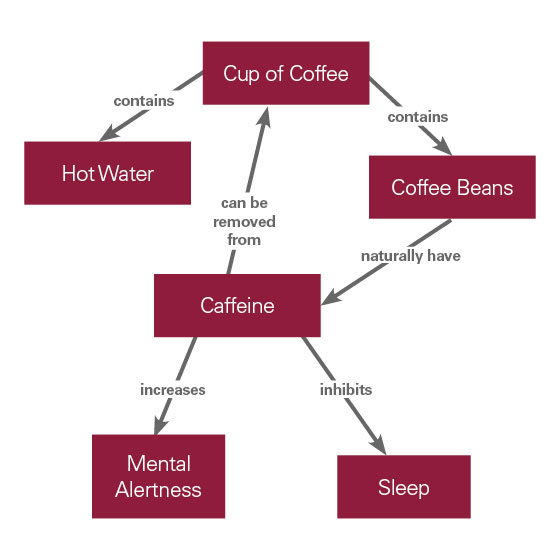Learning in medical school (and medical practice) requires the development of an understanding of patterns and relationships in order to be useful. Each step in learning involves combining what you already know with what you need to know. Understanding concept mapping and its contribution to learning in medical education can be seen by comparing it with standard outlining. First we compare the advantages and disadvantages of both learning methods and then we describe when and how to employ concept mapping as a learning tool.
Outlining is a standard way to organize information for presentation:
I. First item
II. Second item
A. sub item
B. sub item
1. sub-sub item
2. sub-sub item
III. Third item, etc.
What are the advantages of outlining to learning?
It is active learning; decisions must be made to construct the outline.
It organizes information by grouping facts and concepts; learning is at a higher level than just memorization of facts.
What are the disadvantages of outlining to learning?
Relationships and patterns are missed.
Information is assembled by the student as it has already been laid out by someone else.
An effective alternative to outlining is concept mapping.

What are the advantages of concept mapping to learning?
It is active learning; decisions must be made to construct the map.
It organizes information by grouping facts and concepts; learning is at a higher level than just memorization of facts.
It illustrates relationships between facts and concepts through cross-links.
Easy visualization fosters long-term memory; exam reviews are faster and more effective. It guides reading to prevent linear focus; the need to look for groupings and comparisons promotes reading to answer a question.
It fosters self-directed lifelong learning.
What are the disadvantages of concept mapping to learning?
It takes time to learn the process.
When to map?
Use mapping to put things into perspective, to analyze relationships, and to prioritize.
Use mapping to organizing a subject or a case; patient data can be organized to think more clearly about cause and effect and new information needed to determine diagnosis or treatment.
Mapping is a way to integrate old and new knowledge.
Save your maps and review them for preparing for tests. They can be verbalized back into a “story.”
How do I map?
In general, think in terms of key words or paraphrased sentences. Useful items:
- a pencil (you'll be erasing!) and a blank (non-lined) big piece of paper a blackboard and (colored) chalk
- "post-it" notes; a flexible method for arranging the map before recording it.
- free templates available on the web.
Constructing a concept map
- Select the topic to be studied. Since it is going to be subdivided, the size of the topic is not critical. It can be part of a lecture or material that is covered in several lectures.
- Identify by listing on a notepad or highlighting the major concepts from the text, and especially material from the lecture notes that was especially emphasized.
- Rank the concepts (and facts) from most general to most specific.
- Arrange the concept map with the most general concept at the top. Link it to the less inclusive concepts and enclose the text with circles or other shapes. Label lines with linking words that explain the relationship, if needed. Arrowheads can show direction, cause-and-effect, etc.
- Try to branch out at each level of the hierarchy with more than one link.
- Identify and draw cross-links between related concepts. This is a powerful step in developing integrative thinking.
- Alternative patterns: A “spider” or cluster pattern can be constructed from the center outward.
- Leave white space to grow your map for
- further development
- explanations
- action items
- Expand the map over time (right up to an exam if necessary!)
- Compare your maps with others; different groupings or overall organization can teach insight.
Resources: J. W. Pelley TTUHSC School of Medicine
